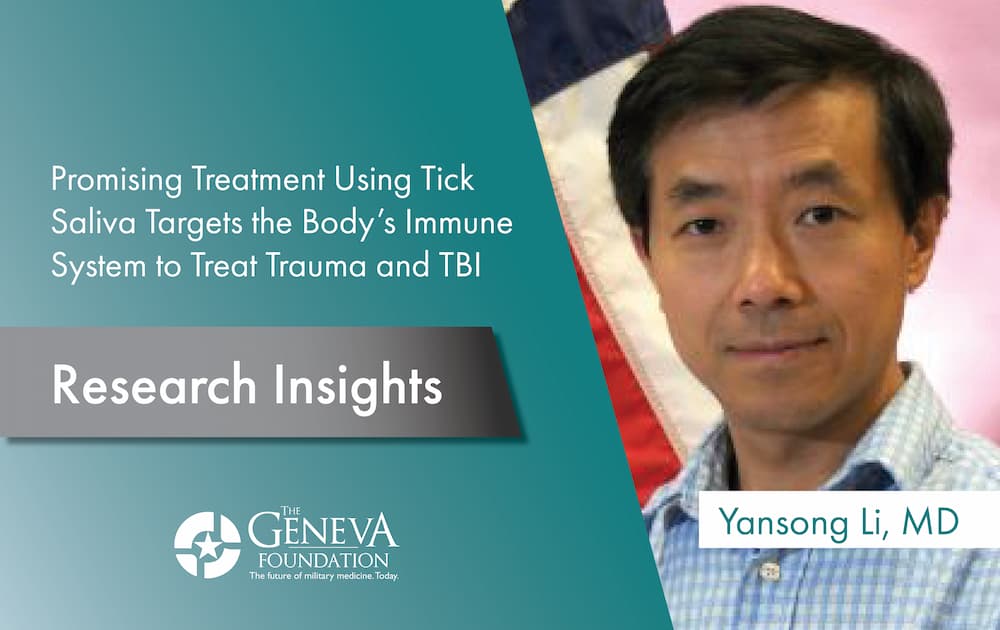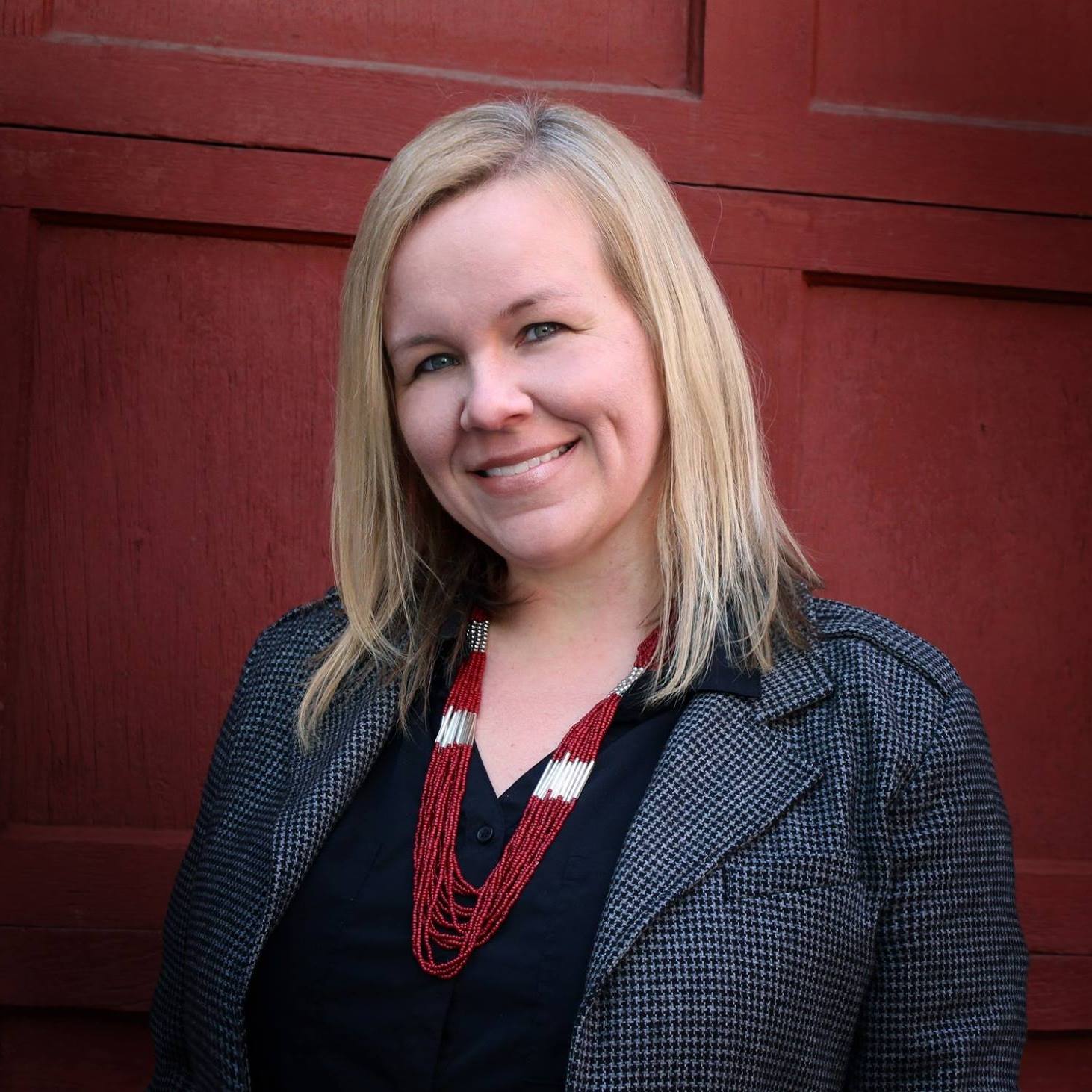4 April 2022
Promising Treatment Using Tick Saliva Targets the Body’s Immune System to Treat Trauma and TBI
Research Insights with Geneva Scientist Yansong Li, MD
Traumatic injuries of all kinds claim the lives of over 150,000 Americans each year. Traumatic brain injury (TBI) is the single largest cause of death from injury in the U.S. The cost: $518 billion globally. The body’s immune system reacts immediately to traumatic injury to fight its effects on tissues and organs but the immune system is complex and it can also overreact – leading to death or long-term disability. Emerging data suggests that targeting aspects of the immune response may offer promising strategies to treat trauma and TBI.
Yansong Li, MD is a translational scientist at The Geneva Foundation who is using a bedside to bench and back to bedside approach to treat trauma and hemorrhagic shock (THS) during prolonged field care (PFC). PFC can be described as “taking care of a patient who you know needs to be somewhere else for much longer than you are comfortable with.”
The current standard of care for trauma patients with multi-organ failure is supportive, such as the use of ventilators or hemodialysis – these are symptom-targeted approaches, and not a mechanism-targeted treatment. “Currently, there are no effective pharmacological therapeutics that address the destructive influence of multi-organ failure for critical THS/TBI patients,” said Dr. Li.
Dr. Li has been studying the body’s immune responses to traumatic hemorrhage since 2007. He was inspired by former colleagues at the Walter Reed Army Institute of Research and the U.S. Army Institute of Surgical Research who completed multiple wartime deployments. Over the span of 15 years, Dr. Li developed a unique trauma immunomodulation research and development program to address this unmet critical medical need.
Harnessing the power of the body’s innate immune system, Dr. Li identified terminal complement activation (TCA) as a therapeutic target and demonstrated that targeting TCA therapy created a pro-survival and organ-protective phenotype in preclinical small animal models of THS/TBI, suggesting that TCA-targeted treatment is a promising therapeutic strategy to treat patients with THS/TBI. “The underlying immunologic disturbance is complex and early activation of the complement cascade plays a crucial role because uncontrolled generation leads to cellular/tissue damage which can lead to death,” said Dr. Li.
With these findings, his research team is now evaluating the efficacy of selected drugs in clinically relevant swine THS/TBI models. One of those treatments uses Nomacopan developed by Akari Therapeutics. Nomacopan is a recombinant small protein derived from a protein originally discovered in the saliva of a tick.
“Nomacopan has 300 million years of product development in ticks. Natural Nomacopan works by damping down the host immune responses, enabling tick to repeatedly feed without damage from host inflammatory substances,” said Dr. Li. “Nomacopan has demonstrated its beneficial effects on improving survival and attenuating organ damage in preclinical models of THS, TBI, sepsis and myocardial infarction.”
The treatment is especially promising for improving trauma recovery to benefit warfighters because of its desirability on the battlefield. In addition to the benefits to the warfighter, this research could lead to lifesaving applications for civilians injured in car accidents or that suffer a TBI while playing sports or suffer a head injury on the job. History has shown us that advances in military medicine also improve the care non-military personnel receive.
“While this research holds promise for improving trauma outcomes on the battlefield, it is equally promising for civilians and athletes that are injured or suffer a head injury on the job or on the field,” commented Geneva Senior Technical Advisor Stephen DeLellis, PA-C, LTC (Ret.), USA who has dedicated his medical career to understanding the effects of TBI in service members and veterans “History has shown us that advances in military medicine translate nicely into civilian health care.“
Akari has recently developed and manufactured a new formulation of Nomacopan, a concentrated lyophilized powder with longer shelf life (up to 3 years) and it is amenable to manufacture in a single use dual chamber autopen for intramuscular injection.
“Obtaining IV access for Nomacopan injection in a THS patient can be difficult or impossible, particularly in austere environments, thereby delaying or preventing its utilization,” said Dr. Li. “Intramuscular injection of Nomacopan could be quickly performed with minimal training by warfighters.”
Dr. Li added, “We hypothesize that PK/PD profiles of intramuscular injection Nomacopan is similar to IV administration and is as a practical alternative when IV access is not available for THS/TBI patients during PFC.”
“With additional funding support from the U.S. Army Medical Research and Development Command (USAMRDC) and the Congressional Directed Medical Research Program (CDMRP), we are confident that our capabilities and strong collaboration with pharmaceutical companies uniquely qualify us to successfully complete this project and advance intramuscular injection Nomacopan to clinical trials within five years,” said Dr. Li.
Recognizing that this work is the result of a team effort, Dr. Li would like to thank his research team including civilian and military research scientists and technicians for their hard work and commitment. He would like to acknowledge Co-Principal Investigator Dr. Leopoldo Cancio, Co-Investigators including Dr. Anthony Pusateri, Dr. Miles Nunn, Dr. Michael Dubick, Dr. Crystal Hill-Pryor, Dr. Andrew Cap, Dr. Susannnah Nicholson, and Dr. Jurandir DalleLucca for their scientific support.
He added that working with his Geneva Portfolio Manager Michelle Norton has helped his team pursue new opportunities and develop new partnerships. “The Geneva Foundation is a wonderful home for translational research scientists,” said Dr. Li. “One can benefit from Geneva’s commitment to strengthening research collaborations, accelerating complex research programs, research management and translating research in a timely manner.”
This research is supported under Award number: BA150310, W81XWH-19-2-0040 and W81XWH-20-2-0040 through a grant from the U.S. Army Medical Research & Development Command’s Broad Agency Announcement.
Disclaimer: The views expressed do not reflect the official policy of the Army, the Department of Defense, or the U.S. Government.

"Nomacopan has 300 million years of product development in ticks. Natural Nomacopan works by damping down the host immune responses, enabling tick to repeatedly feed without damage from host inflammatory substances,"
Yansong Li, MD
HIGHLIGHTS
- The body’s immune system reacts immediately to traumatic injury to fight its effects on tissues and organs but the immune system is complex and it can also overreact – leading to death or long-term disability. Emerging data suggests that targeting aspects of the immune response may offer promising strategies to treat trauma and TBI.
- Yansong Li, MD is a translational scientist who is using a bedside to bench and back to bedside approach to treat trauma and hemorrhagic shock (THS) . He has been studying this unmet critical medical need since 2007.
- Harnessing the power of the body’s innate immune system, Dr. Li identified terminal complement activation (TCA) as a therapeutic target and demonstrated that targeting TCA therapy created a pro-survival and organ-protective phenotype in preclinical small animal models of THS/TBI.
- Nomacopan is a recombinant small protein derived from a protein originally discovered in the saliva of a tick. Nomacopan has demonstrated its beneficial effects on improving survival and attenuating organ damage in preclinical models of THS, TBI, sepsis and myocardial infarction.
- Intramuscular injection of Nomacopan could be quickly performed with minimal training by warfighters.


